The Characteristics of the Abnormal Day-to-Day TEC Variation above East Asian Region
Abstract
1. Introduction
2. Method
3. Result
3.1. Temporal and Spatial Distribution of TEC Anomaly
3.2. Moving Anomaly of TEC Day-To-Day Variation
3.3. TEC Anomaly before Large Earthquakes and Geomagnetic Storms
4. Discussion
5. Conclusions
- The positive anomaly occurs frequently at the middle latitude at UT 06–12, which is about LT 14–20, and frequently around 28° N at UT 14–20, which is mainly at about LT 22–00.
- The negative anomaly occurs frequently at middle latitude at UT 02–18. They obviously occur less frequently at low latitudes (about 15° N~30° N) at UT 00–04, which is LT 08–12, and occur less frequently near the Equator Ionization Anomaly area (about 22° N~30° N) at UT 06–12, which is mainly at LT 14–18.
- The quantities of positive anomalies and negative anomalies are comparable. The direction of moving anomalies is from east to west in a zonal direction in all conditions. The moving speeds of anomalies are around 15~19 degrees per hour in the zonal direction and seem to grow as the latitude increases.
- The moving anomalies may occur in each temporal bin with similar probability. They are nearly evenly distributed in geography by longitude and occur more at middle latitudes.
- TEC anomalies occur in 22.1% of temporal bins before large earthquakes within 7 days, which may correlate to the earthquakes or not, and occur in 24% of temporal bins in the interval, which is within 1 day before and 3 days later than the main phase of geomagnetic storms.
Author Contributions
Funding
Institutional Review Board Statement
Informed Consent Statement
Data Availability Statement
Acknowledgments
Conflicts of Interest
References
- Forbes, J.M.; Palo, S.E.; Zhang, X. Variability of the ionosphere. J. Atmos. Sol. Terr. Phys. 2000, 62, 685–693. [Google Scholar] [CrossRef]
- Schunk, R.W.; Nagy, A.F. Ionospheres: Physics, Plasma Physics, and Chemistry; Cambridge University Press: New York, USA, 2009. [Google Scholar]
- Goncharenko, L.P.; Chau, J.L.; Liu, H.-L.; Coster, A.J. Unexpected connections between the stratosphere and ionosphere. Geophys. Res. Lett. 2010, 37, L10101. [Google Scholar] [CrossRef]
- Rishbeth, H.; Mendillo, M. Patterns of F2-layer variability. J. Atmos. Sol. Terr. Phys. 2001, 63, 1661–1680. [Google Scholar] [CrossRef]
- Moore, L.; Mendillo, M.; Martinis, C.; Bailey, S. Day-to-day variability of the E layer. J. Geophys. Res. 2006, 111, A06307. [Google Scholar] [CrossRef]
- Shim, J.S.; Scherliess, L.; Schunk, R.W.; Thompson, D.C. Spatial correlations of day-to-day ionospheric total electron content variability obtained from ground-based GPS. J. Geophys. Res. 2008, 113, A09309. [Google Scholar] [CrossRef]
- Xiong, B.; Wan, W.; Yu, Y.; Hu, L. Investigation of ionospheric TEC over China based on GNSS Data. Adv. Space Res. 2016, 58, 867–877. [Google Scholar] [CrossRef]
- Fang, T.W.; Fuller-Rowell, T.; Yudin, V.; Matsuo, T.; Viereck, R. Quantifying the sources of ionosphere day-to-day variability. J. Geophys. Res. Space Phys. 2018, 123, 9682–9696. [Google Scholar] [CrossRef]
- Zhou, X.; Yue, X.; Liu, H.-L.; Lu, X.; Wu, H.; Zhao, X.; He, J. A comparative study of ionospheric day-to-day variability over Wuhan based on ionosonde measurements and model simulations. J. Geophys. Res. Space Phys. 2021, 126, e2020JA028589. [Google Scholar] [CrossRef]
- Ban, P.; Guo, L.; Zhao, Z.; Sun, S.; Zhang, H.; Wang, F.; Xu, Z.; Sun, F.; Xu, T. A new index to descript the regional ionospheric disturbances during storm time. J. Geophys. Res. Space Phys. 2022, 127, e2021JA030126. [Google Scholar] [CrossRef]
- Abdelazeem, M.; Çelik, R.N.; El-Rabbany, A. An enhanced real-time regional ionospheric model using IGS real-time service (IGS-RTS) products. J. Navig. 2016, 69, 521–530. [Google Scholar] [CrossRef]
- Başçiftçi, F.; Cevat, I.N.A.L.; Yildirim, O.; Bulbul, S. Comparison of regional and global TEC values: Turkey model. Int. J. Eng. Geosci. 2018, 3, 61–72. [Google Scholar] [CrossRef]
- Abdallah, A.; Agag, T.; Schwieger, V. Method of Development of a New Regional Ionosphere Model (RIM) to Improve Static Single-Frequency Precise Point Positioning (SF-PPP) for Egypt Using Bernese GNSS Software. Remote Sens. 2023, 15, 3147. [Google Scholar] [CrossRef]
- Wu, Y.W.; Liu, R.Y.; Zhang, B.C.; Wu, Z.S.; Ping, J.S.; Liu, J.M.; Hu, Z.J. Variations of the ionospheric TEC using simultaneous measurements from the China Crustal Movement Observation Network. Ann. Geophys. 2012, 30, 1423–1433. [Google Scholar] [CrossRef][Green Version]
- Le, H.; Liu, J.Y.; Liu, L. A statistical analysis of ionospheric anomalies before 736 M6.0+ earthquakes during 2002–2010. J. Geophys. Res. Space Phys. 2011, 11, EGU2011-389. [Google Scholar]
- Dobrovolsky, I.R.; Zubkov, S.I.; Myachkin, V.I. Estimation of the size of earthquake preparation zones. Pure Appl. Geophys. 1979, 117, 1025–1044. [Google Scholar] [CrossRef]
- Bilitza, D. International Reference Ionosphere 2000. Radio Sci. 2001, 36, 261–275. [Google Scholar] [CrossRef]
- Romero-Hernandez, E.; Denardini, C.M.; Takahashi, H.; Gonzalez-Esparza, J.A.; Nogueira, P.A.B.; de Pádua, M.B.; Lotte, R.G.; Negreti, P.M.D.S.; Jonah, O.F.; Resende, L.C.A.; et al. Daytime ionospheric TEC weather study over Latin America. J. Geophys. Res. Space Phys. 2018, 123, 10,345–10,357. [Google Scholar] [CrossRef]
- Jonah, O.F.; de Paula, E.R.; Muella, M.T.A.H.; Dutra, S.L.G.; Kherani, E.A.; Negreti, P.M.S.; Otsuka, Y. TEC variation during high and low solar activities over South American sector. J. Atmos. Sol. Terr. Phys. 2015, 135, 22–35. [Google Scholar] [CrossRef]
- Laštovička, J. Forcing of the ionosphere by waves from below. J. Atmos. Sol. Terr. Phys. 2006, 68, 479–497. [Google Scholar] [CrossRef]
- Tanaka, T. Severe ionospheric disturbances caused by the sudden response of evening subequatorial ionospheres to geomagnetic storms. J. Geophys. Res. 1981, 86, 11,335–11,349. [Google Scholar] [CrossRef]
- Prölss, G.W. Density perturbations in the upper atmosphere caused by the dissipation of solar wind energy. Surv. Geophys. 2011, 32, 101–195. [Google Scholar] [CrossRef]
- Pulinets, S.; Boyarchuk, K. Ionospheric Precursors of Earthquakes; Springer: Berlin/Heidelberg, Germany, 2005. [Google Scholar] [CrossRef]
- Liu, J.Y.; Chen, Y.I.; Pulinets, S.A.; Tsai, Y.B.; Chuo, Y.J. Seismo-ionospheric signatures prior to M > 6.0 Taiwan earthquakes. Geophys. Res. Lett. 2000, 27, 3113–3116. [Google Scholar] [CrossRef]
- Liu, J.Y.; Chen, Y.I.; Chuo, Y.J.; Tsai, H.F. Variations of ionospheric total electron content during the chi-chi earthquake. Geophys. Res. Lett. 2001, 28, 1383–1386. [Google Scholar] [CrossRef]
- Liu, J.Y.; Chuo, Y.J.; Shan, S.J.; Tsai, Y.B.; Chen, Y.I.; Pulinets, S.A.; Yu, S.B. Pre-earthquake ionospheric anomalies registered by continuous GPS TEC measurements. Ann. Geophys. 2004, 22, 1585–1593. [Google Scholar] [CrossRef]
- Zhao, B.; Yu, T.; Wang, M.; Wan, W.; Lei, J.; Liu, L.; Ning, B. Is an unusual large enhancement of ionospheric electron density linked with the 2008 great Wenchuan earthquake? J. Geophys. Res. 2008, 113, A11304. [Google Scholar] [CrossRef]
- Liu, J.Y.; Chen, Y.I.; Chen, C.H.; Liu, C.Y.; Chen, C.Y.; Nishihashi, M.; Li, J.Z.; Xia, Y.Q.; Oyama, K.I. Seismoionospheric GPS total electron content anomalies observed before the 12 May 2008 Mw7.9 Wenchuan earthquake. J. Geophys. Res. 2009, 114, A04320. [Google Scholar] [CrossRef]
- Zhou, C.; Liu, Y.; Zhao, S.; Liu, J.; Zhang, X.; Huang, J.; Shen, X.; Ni, B.; Zhao, Z. An electric field penetration model for seismoionospheric research. Adv. Space Res. 2017, 60, 2217–2232. [Google Scholar] [CrossRef]
- Sorokin, V.M.; Chmyrev, V.M.; Hayakawa, M. A review on electrodynamic influence of atmospheric processes to the ionosphere. Open J. Earthq. Res. 2020, 9, 113–141. [Google Scholar] [CrossRef]
- Li, M.; Shen, X.; Parrot, M.; Zhang, X.; Zhang, Y.; Yu, C.; Yan, R.; Liu, D.; Lu, H.; Guo, F.; et al. Primary joint statistical seismic influence on ionospheric parameters recorded by the CSES and DEMETER Satellites. J. Geophys. Res. Space Phys. 2020, 125, e2020JA028116. [Google Scholar] [CrossRef]
- Song, R.; Hattori, K.; Zhang, X.; Sanaka, S. Seismic-ionospheric effects prior to four earthquakes in Indonesia detected by the China seismo-electromagnetic satellite. J. Atmos. Sol. Terr. Phys. 2020, 205, 105291. [Google Scholar] [CrossRef]
- Liu, J.; Wang, W.; Zhang, X.; Wang, Z.; Zhou, C. Ionospheric total electron content anomaly possibly associated with the April 4, 2010 Mw7.2 Baja California earthquake. Adv. Space Res. 2022, 5, 69. [Google Scholar] [CrossRef]

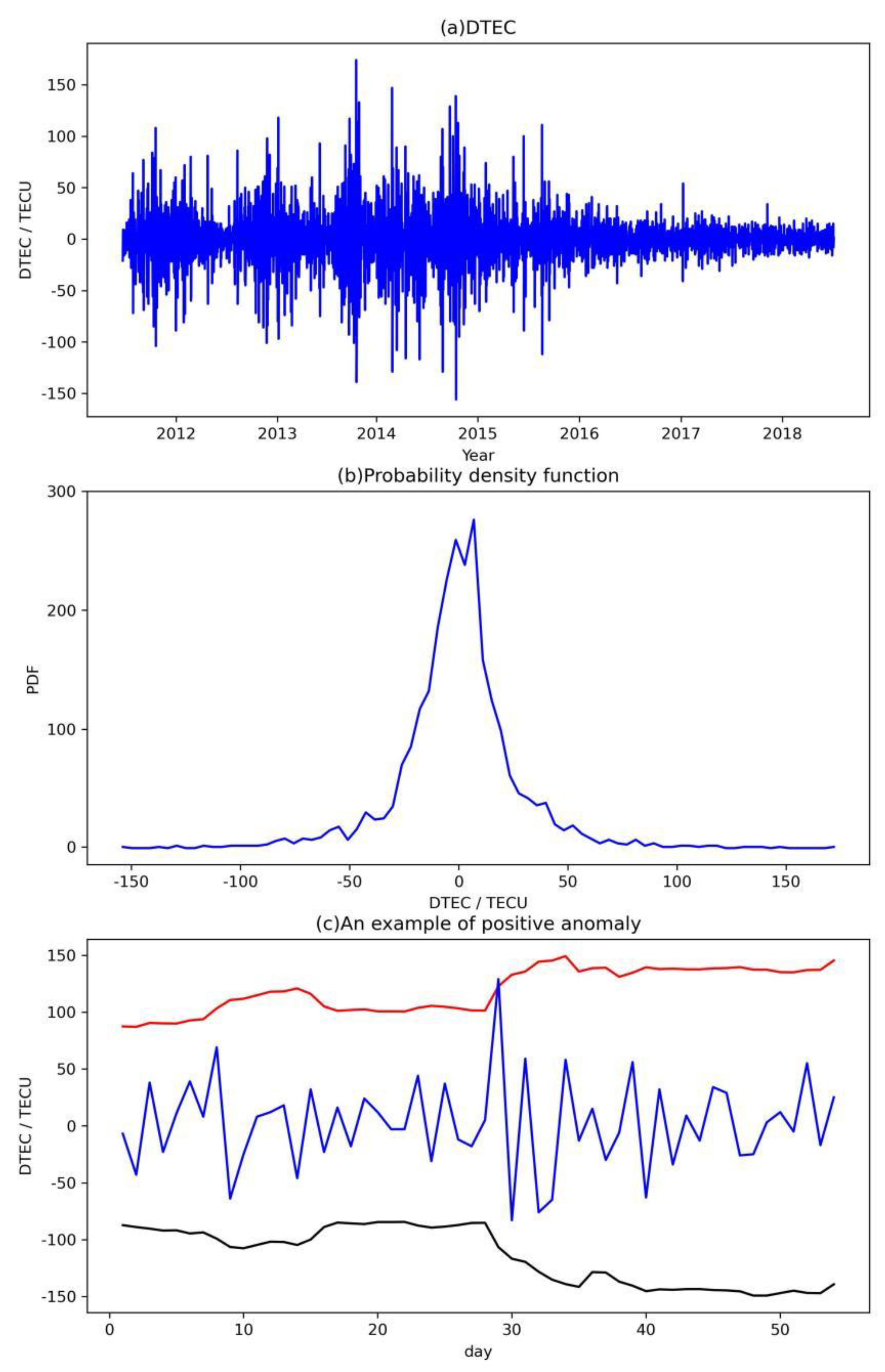
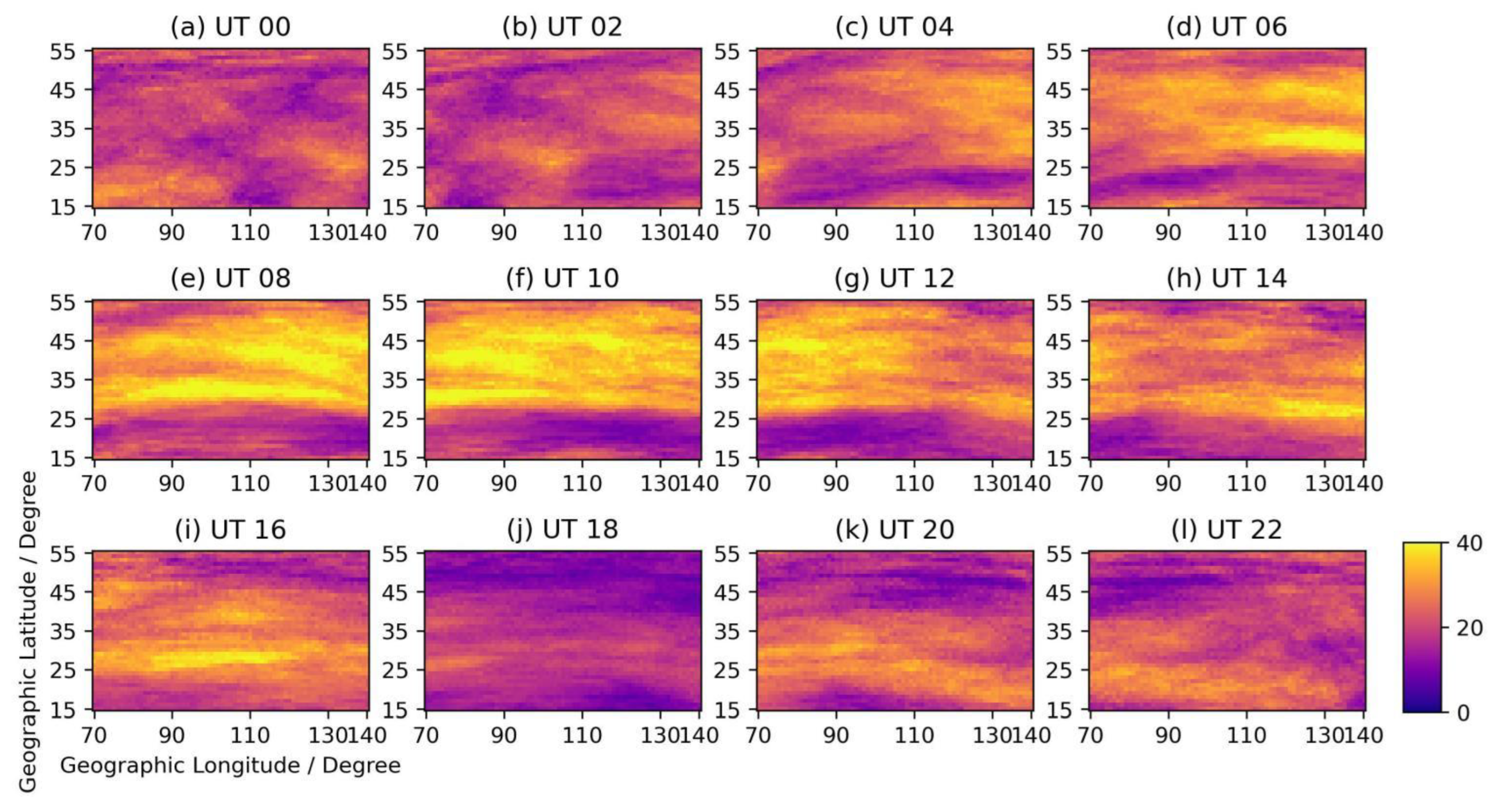
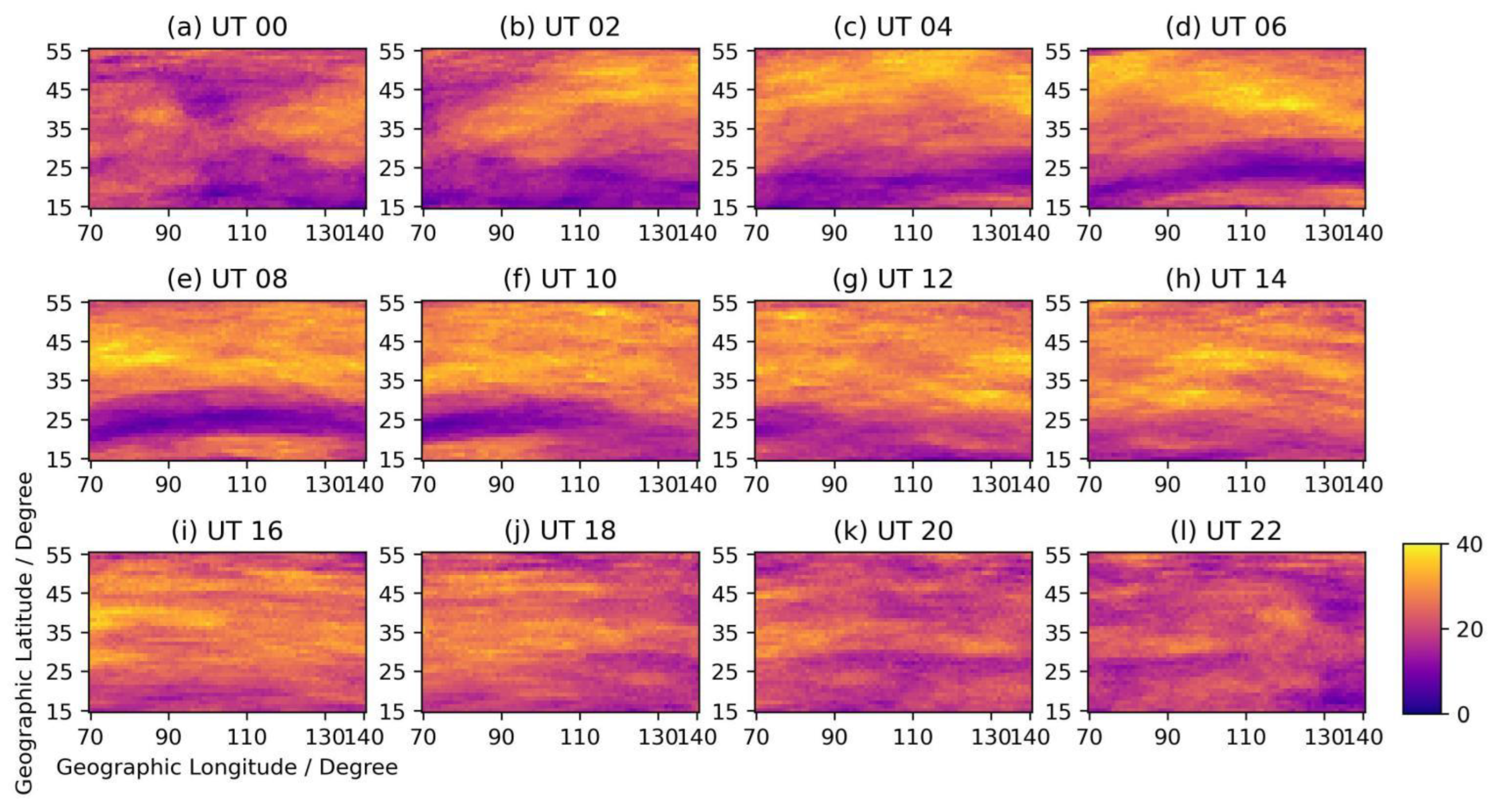
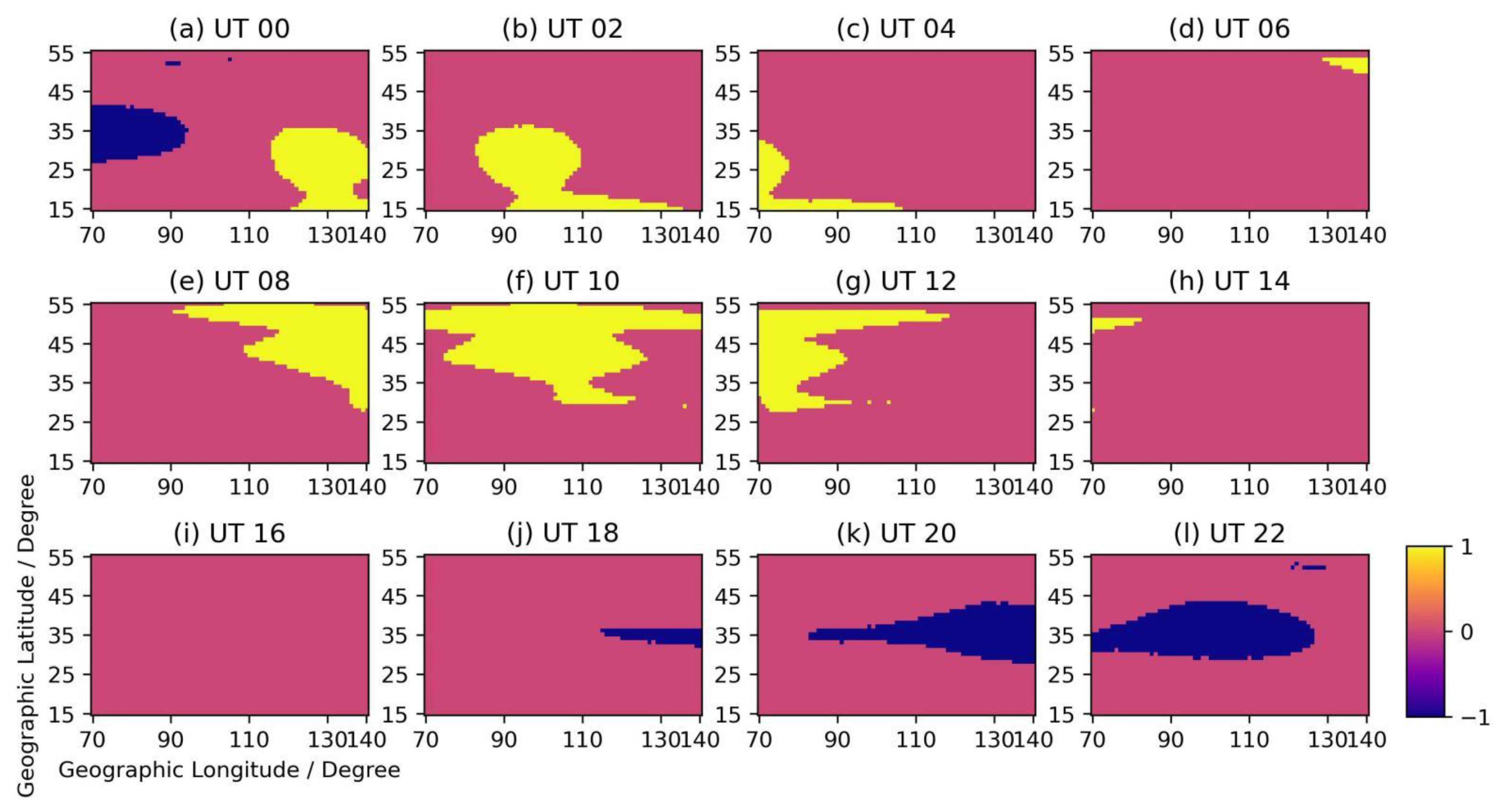
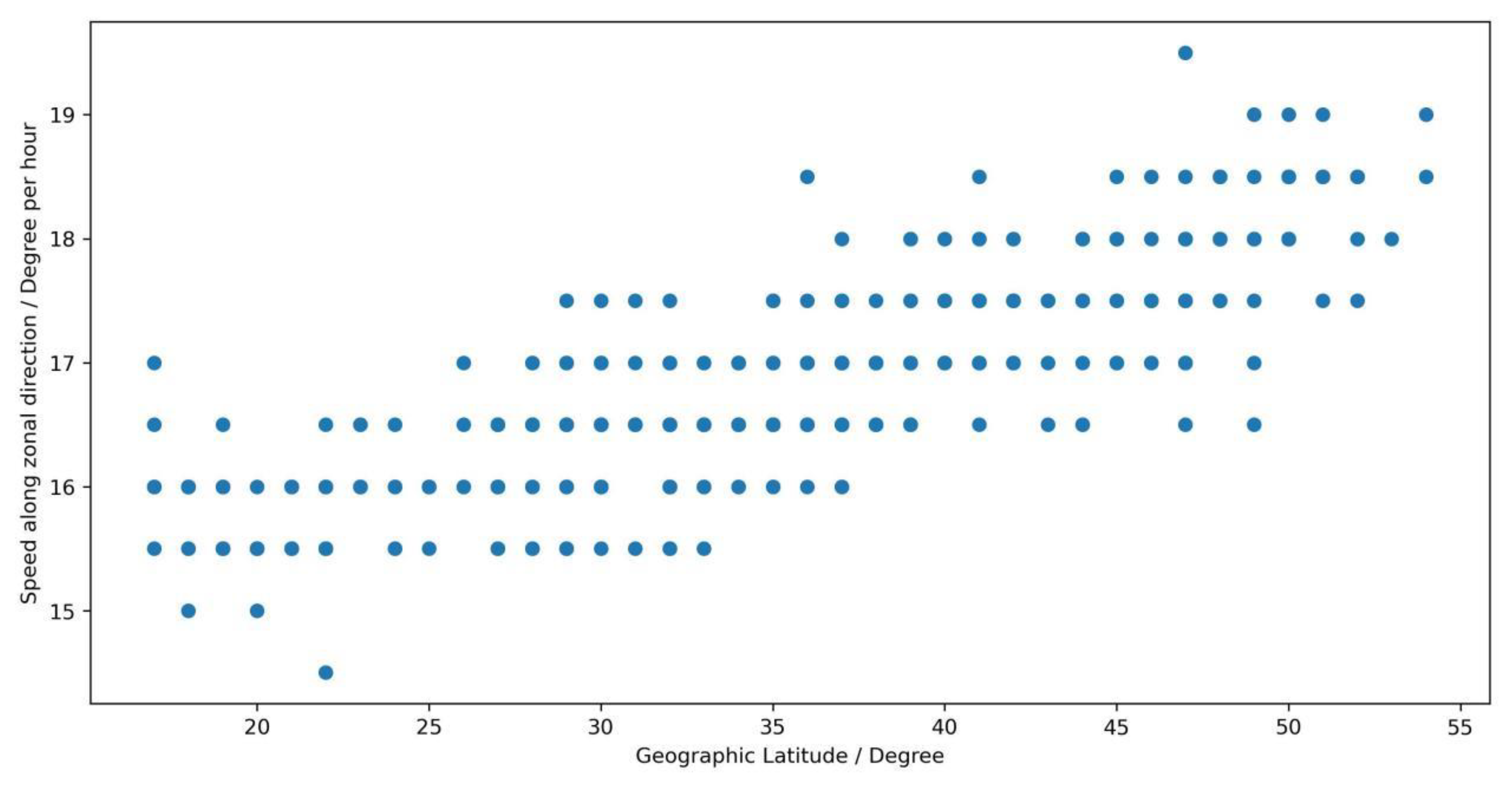
Disclaimer/Publisher’s Note: The statements, opinions and data contained in all publications are solely those of the individual author(s) and contributor(s) and not of MDPI and/or the editor(s). MDPI and/or the editor(s) disclaim responsibility for any injury to people or property resulting from any ideas, methods, instructions or products referred to in the content. |
© 2023 by the authors. Licensee MDPI, Basel, Switzerland. This article is an open access article distributed under the terms and conditions of the Creative Commons Attribution (CC BY) license (https://creativecommons.org/licenses/by/4.0/).
Share and Cite
Su, F.; Yang, J.; Hu, L.; Zhu, F. The Characteristics of the Abnormal Day-to-Day TEC Variation above East Asian Region. Atmosphere 2023, 14, 1493. https://doi.org/10.3390/atmos14101493
Su F, Yang J, Hu L, Zhu F. The Characteristics of the Abnormal Day-to-Day TEC Variation above East Asian Region. Atmosphere. 2023; 14(10):1493. https://doi.org/10.3390/atmos14101493
Chicago/Turabian StyleSu, Fanfan, Jian Yang, Liangchen Hu, and Fuying Zhu. 2023. "The Characteristics of the Abnormal Day-to-Day TEC Variation above East Asian Region" Atmosphere 14, no. 10: 1493. https://doi.org/10.3390/atmos14101493
APA StyleSu, F., Yang, J., Hu, L., & Zhu, F. (2023). The Characteristics of the Abnormal Day-to-Day TEC Variation above East Asian Region. Atmosphere, 14(10), 1493. https://doi.org/10.3390/atmos14101493









